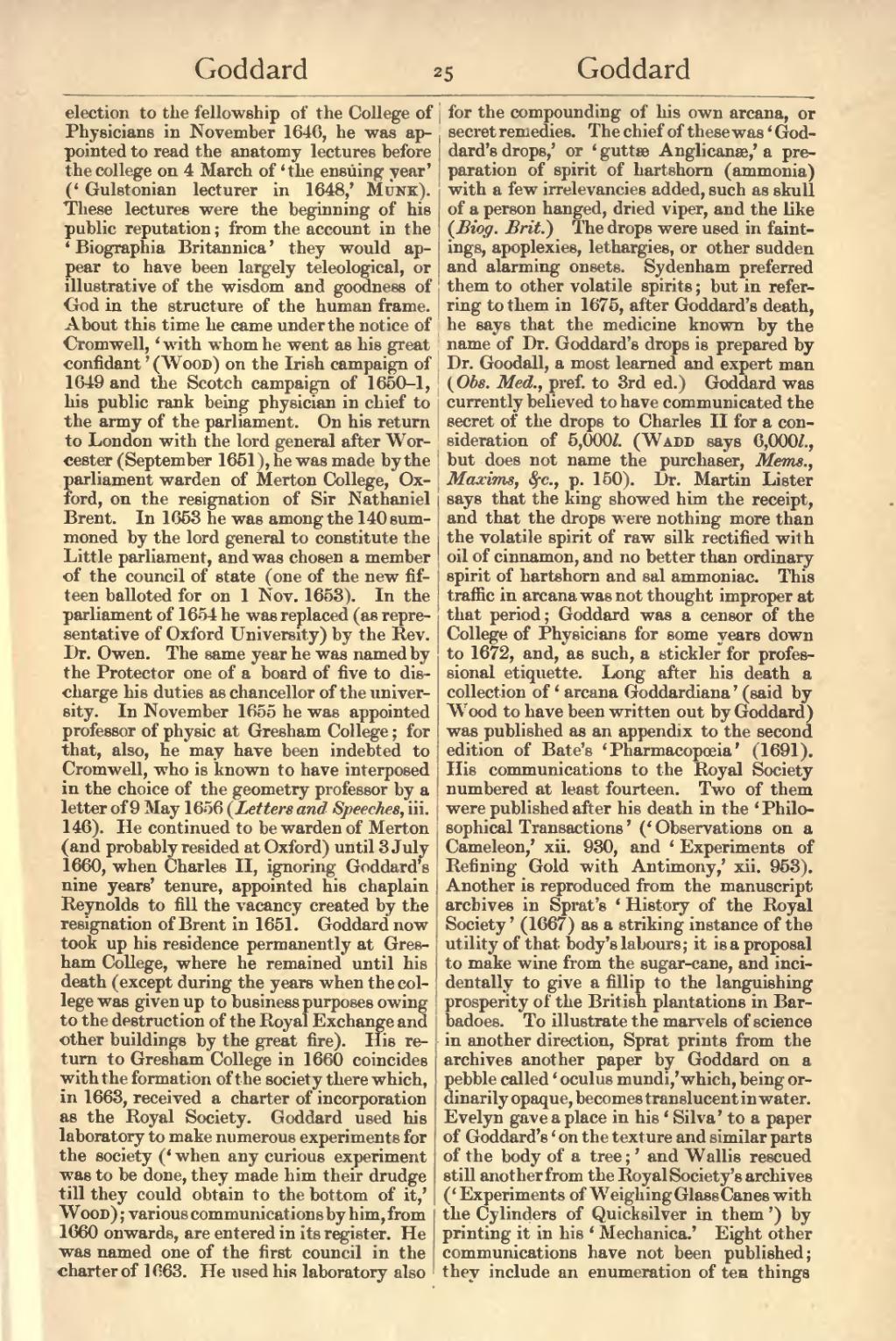election to the fellowship of the College of Physicians in November 1646, he was appointed to read the anatomy lectures before the college on 4 March of ‘the ensuing year’ (‘Gulstonian lecturer in 1648,’ Munk). These lectures were the beginning of his public reputation; from the account in the ‘Biographia Britannica’ they would appear to have been largely teleological, or illustrative of the wisdom and goodness of God in the structure of the human frame. About this time he came under the notice of Cromwell, ‘with whom he went as his great confidant’ (Wood) on the Irish campaign of 1649 and the Scotch campaign of 1650–1, his public rank being physician in chief to the army of the parliament. On his return to London with the lord general after Worcester (September 1651), he was made by the parliament warden of Merton College, Oxford, on the resignation of Sir Nathaniel Brent. In 1653 he was among the 140 summoned by the lord general to constitute the Little parliament, and was chosen a member of the council of state (one of the new fifteen balloted for on 1 Nov. 1653). In the parliament of 1654 he was replaced (as representative of Oxford University) by the Rev. Dr. Owen. The same year he was named by the Protector one of a board of five to discharge his duties as chancellor of the university. In November 1655 he was appointed professor of physic at Gresham College; for that, also, he may have been indebted to Cromwell, who is known to have interposed in the choice of the geometry professor by a letter of 9 May 1656 (Letters and Speeches, iii. 146). He continued to be warden of Merton (and probably resided at Oxford) until 3 July 1660, when Charles II, ignoring Goddard's nine years' tenure, appointed his chaplain Reynolds to fill the vacancy created by the resignation of Brent in 1651. Goddard now took up his residence permanently at Gresham College, where he remained until his death (except during the years when the college was given up to business purposes owing to the destruction of the Royal Exchange and other buildings by the great fire). His return to Gresham College in 1660 coincides with the formation of the society there which, in 1663, received a charter of incorporation as the Royal Society. Goddard used his laboratory to make numerous experiments for the society (‘when any curious experiment was to be done, they made him their drudge till they could obtain to the bottom of it,’ Wood); various communications by him, from 1660 onwards, are entered in its register. He was named one of the first council in the charter of 1663. He used his laboratory also for the compounding of his own arcana, or secret remedies. The chief of these was ‘Goddard's drops,’ or ‘guttæ Anglicanæ,’ a preparation of spirit of hartshorn (ammonia) with a few irrelevancies added, such as skull of a person hanged, dried viper, and the like (Biog. Brit.) The drops were used in faintings, apoplexies, lethargies, or other sudden and alarming onsets. Sydenham preferred them to other volatile spirits; but in referring to them in 1675, after Goddard's death, he says that the medicine known by the name of Dr. Goddard's drops is prepared by Dr. Goodall, a most learned and expert man (Obs. Med., pref. to 3rd ed.). Goddard was currently believed to have communicated the secret of the drops to Charles II for a consideration of 5,000l. (Wadd says 6,000l., but does not name the purchaser, Mems., Maxims, &c., p. 150). Dr. Martin Lister says that the king showed him the receipt, and that the drops were nothing more than the volatile spirit of raw silk rectified with oil of cinnamon, and no better than ordinary spirit of hartshorn and sal ammoniac. This traffic in arcana was not thought improper at that period; Goddard was a censor of the College of Physicians for some years down to 1672, and, as such, a stickler for professional etiquette. Long after his death a collection of ‘arcana Goddardiana’ (said by Wood to have been written out by Goddard) was published as an appendix to the second edition of Bate's ‘Pharmacopœia’ (1691). His communications to the Royal Society numbered at least fourteen. Two of them were published after his death in the ‘Philosophical Transactions’ (‘Observations on a Cameleon,’ xii. 930, and ‘Experiments of Refining Gold with Antimony,’ xii. 953). Another is reproduced from the manuscript archives in Sprat's ‘History of the Royal Society’ (1667) as a striking instance of the utility of that body's labours; it is a proposal to make wine from the sugar-cane, and incidentally to give a fillip to the languishing prosperity of the British plantations in Barbadoes. To illustrate the marvels of science in another direction, Sprat prints from the archives another paper by Goddard on a pebble called ‘oculus mundi,’ which, being ordinarily opaque, becomes translucent in water. Evelyn gave a place in his ‘Silva’ to a paper of Goddard's ‘on the texture and similar parts of the body of a tree;’ and Wallis rescued still another from the Royal Society's archives (‘Experiments of Weighing Glass Canes with the Cylinders of Quicksilver in them’) by printing it in his ‘Mechanica.’ Eight other communications have not been published; they include an enumeration of ten things
Page:Dictionary of National Biography volume 22.djvu/31
